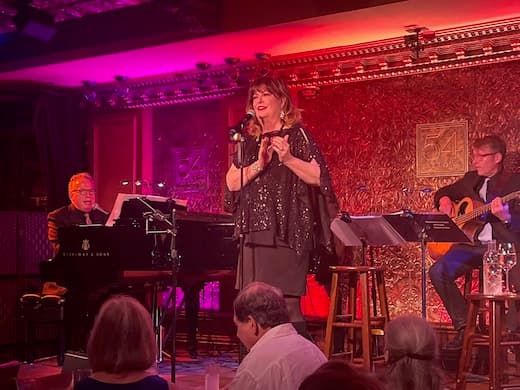Ann Hampton Callaway Breathes New Life Into the Sounds of the ’70s
There’s nary a tune here that even I don’t know by heart, and the 1970s is hardly my favorite musical decade. This, though, is far from a jukebox musical or a night of karaoke.

‘Ann Hampton Callaway Sings The Seventies’
54 Below
Through August 12
We feel the earth move under Ann Hampton Callaway’s feet. The title of the latest offering by the formidable singer, pianist, and composer, “Ann Hampton Callaway Sings The Seventies,” is on the nose. The repertoire is as well: 13 well-known songs by a half-dozen or so iconic singer-songwriters.
Her onstage patter often follows a similar pattern: Wearing tall, black boots and a black, glittery shawl, she asked, “Are there any Carole King fans in the house?” “Are there any Joni Mitchell fans in the audience?”
The song list is, in fact, surprising for its very lack of surprises; there’s nary a tune here that even I don’t know by heart, and the 1970s is hardly my favorite musical decade.
This, though, is far from a jukebox musical or a night of karaoke: Ms. Callaway and her musical director, Billy Stritch, doubling as back-up vocalist and tripling as duet partner, found a thoughtful approach to very familiar songs to make us hear them in a whole new light. They were aided by bassist Martin Wind, playing an acoustic bass guitar (a fretted, four-stringed instrument), and drummer Tim Horner,
Of all the evening’s songs, Carole King’s “I Feel the Earth Move” seemed like the only instance wherein Ms. Callaway took a classic recording and recreated it as closely as possible. Apparently the opening song from “Tapestry” is too much of a cultural milestone for anyone to monkey with.
Other songs were thoughtfully reconsidered, not necessarily jazzed up in obvious ways, but with subtle jazz elements incorporated: new harmonies, different time feels, the occasional scat interlude; even “I Feel The Earth Move” had a soul jazz piano solo by Mr. Stritch at the center.
Nearly every show by Ms. Callaway and her sister, the more musical theater-oriented Liz Callaway (who appeared on this stage and in these pages last month), is held together by an autobiographical framework. It impresses me that after seeing at least 10 different shows by each of them, the Callaways are still extracting stories from their past that I haven’t heard before.
Ms. Callaway linked her discovery of Ms. King, Ms. Mitchell, James Taylor, and Linda Ronstadt to a record store at Riverdale where she blew her weekly allowance on discount vinyl.
The show also seems like a Whitman sampler; after hearing her do two songs by Ms. Mitchell and one by Mr. Taylor, I yearn to see entire sets of Ms. Callaway addressing their songbooks. The two Mitchell songs were a study in contrast: for “A Case of You,” she accompanied herself at the piano and came through with the most intimate and vulnerable performance of the evening. Contrastingly, “Big Yellow Taxi” was reinvigorated with a funky backbeat and an extrovert attitude — now you can really hear the screen door slam. She could have retitled it, “Big Yellow Uber.”
On “Tracks of My Tears,” performed here in honor of Ms. Ronstadt rather than composer Smokey Robinson, Mr. Stritch served as a highly effective secondary voice. Later, as a full-on co-star on “Come in from the Rain,” the two voices moved us all deeply with a song that, having heard it too much in 1975, I didn’t think I ever wanted to hear again. They proved me wrong.
On “Tracks,” Mr. Stritch played a very churchy piano solo, almost turning a torch song into a hymn. Then Ms. Callaway’s stark, spare interpretation of John Lennon’s “Imagine,” with Mr. Horner switching to hand percussion, was a deeply moving secular prayer, a plea to a God whom the lyric insists doesn’t exist.
And still there were surprises: Mel Torme reimagined “New York State of Mind” as a jazz anthem, and Tony Bennett reworked it as a masterful duet with composer Billy Joel himself; Ms. Callaway and Mr. Stritch set it against Benny Golson’s hard-bop standard “Killer Joe,” which somehow made the well-known song seem even more relevant to the creepy, scary, pre-Disney New York of the 1970s, at least the New York that I remember.
Are there any Ann Hampton Callaway fans in the house? Fifty years later, the earth is still moving.

